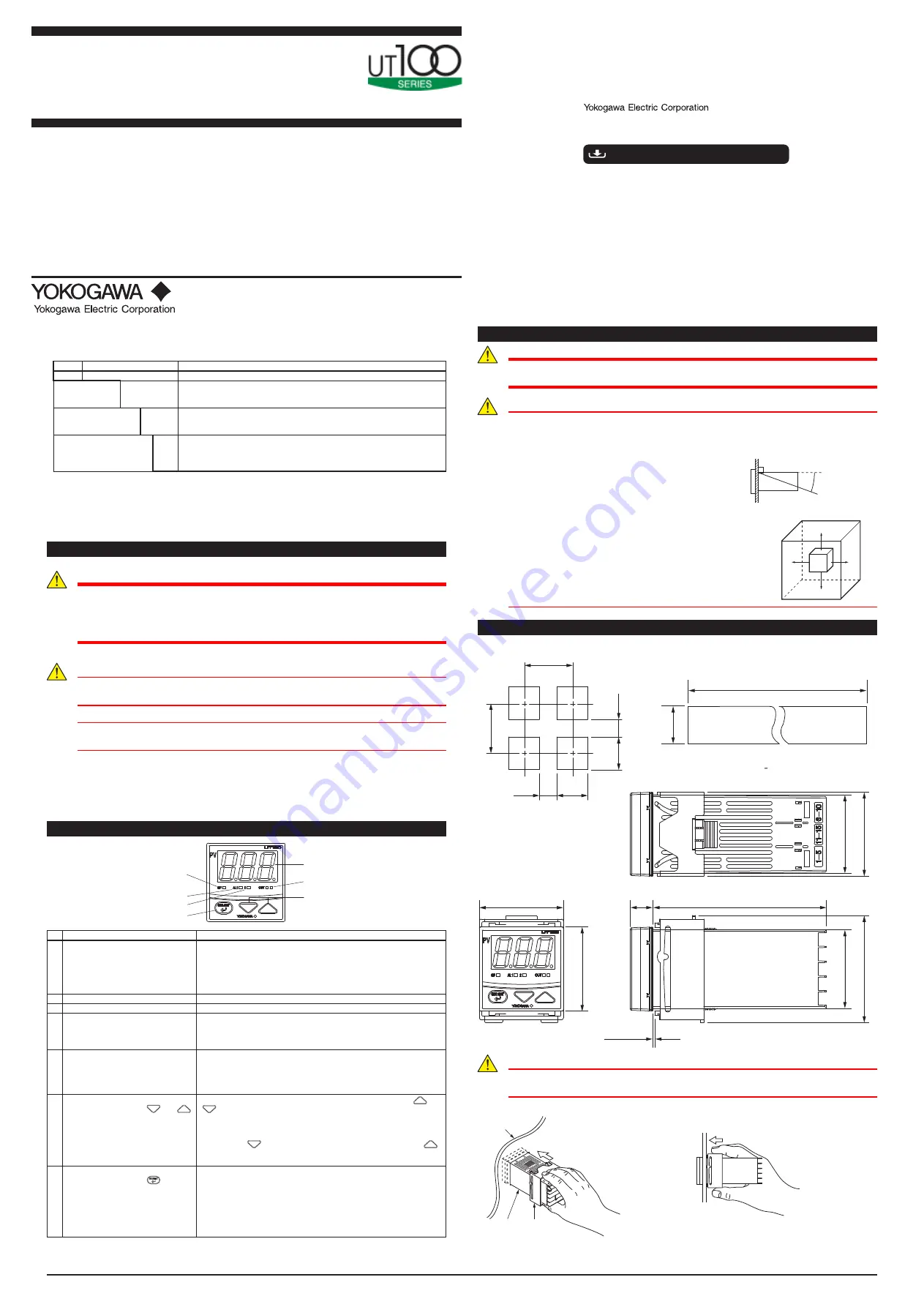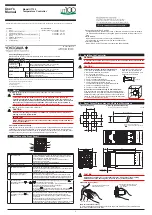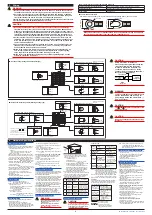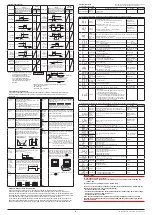
2-9-32, Naka-cho Musashino-shi, Tokyo 180-8750 Japan
Phone: +81-422-52-7179 Facsimile: +81-422-52-6793
http://www.yokogawa.com/ns/ut/im/
You can download the latest manuals from the following website:
User’s
Manual
• Authorised Representative in the EEA
Yokogawa Europe BV. (Address: Euroweg 2 , 3825 HD Amersfoort, The Netherlands) is
the Authorised Representative of Yokogawa Electric Corporation for this Product in the
EEA.
• Printed Manuals
Model UT130 Temperature Controller (IM 05C01E02-01E)
UT100 Series Communication Functions (IM 05C01E12-10E)
•
General Specifications
Model UT130, UT150 Temperature Controller (GS 05C01E02-01E)
1
■
Checking Package Contents
Before using the product, check that its model & suffix codes are as you ordered.
Model and Suffix Codes
Model
Suffix code
Description
UT130
Temperature controller
Control output for
standard type
(or for heating)
–R
–V
Relay output (time-proportional PID or on/off control)
Voltage pulse output (time-proportional PID)
Control output for
cooling
N
R
V
No cooling output (standard type)
Relay output (time-proportional PID or on/off control)
Voltage pulse output (time-proportional PID)
Option
/AL
/HBA
/RS
/V24
Alarm outputs (2 points)
Heater disconnection alarm (includes optional /AL function)
Communication function
Power Supply 24V DC / 24V AC
Note: When specifying the /RS option, be sure to order the required number of copies of Communication Functions User’s Manual separeately.
Check the package contents against the list below.
• Temperature controller …………………… 1
• Mounting bracket
………………………… 1
• User’s manual (this manual)
…………… 1
1. Notice
The following safety symbol is used both on the product and in this user’s manual.
WARNING
This symbol stands for “Handle with Care.” When displayed on the product, the
operator should refer to the corresponding explanation given in the user’s manual in
order to avoid injury or death of personnel and/or damage to the product. In the manual
the symbol is accompanied by an explanation of the special care that is required to
avoid shock or other dangers that may result in injury or loss of life.
The following symbols are used in this manual only.
CAUTION
Indicates that operating the hardware or software in a particular manner may lead to
damage or result in system failure.
IMPORTANT
Draws attention to information that is essential for understanding the operation and/or
features of the product.
■
Exemption from Responsibility
Make sure that all of the precautions are strictly adhered to. Yokogawa Electric Corporation assumes
no liability for any damage resulting from use of the instrument in contradiction to the precautions.
Also, Yokogawa Electric Corporation assumes no liability to any party for any loss or damage, direct
or indirect, caused by the use or any unpredictable defect of the instrument.
2. What is on the Front Panel ?
a.
g.
e.
d.
c.
f.
b.
Name
Function
a. Data display (red)
• In the operating display, either PV (measured value) or SP (target
setpoint) is indicated. Which parameter takes precedence over the
other depends on the DSP parameter value.
• In the parameter setting display, either the parameter codes or
parameter value is indicated.
• If an error occurs, the error code is displayed.
b. Alarm 1 (AL1) lamp (red)
Lit when alarm 1 is activated.
c. Alarm 2 (AL2) lamp (red)
Lit when alarm 2 is activated.
d. SP display lamp (orange)
• Lit when the SP is displayed or being changed.
• Flashes slowly (approx. once every second) when a parameter code
is displayed.
• Flashes fast when a parameter value is being changed.
e. Output (OUT) display lamps
(Left: orange; right: green)
Lit while control output is being output.
• The left lamp is lit in orange during control output of standard type.
• In heating/cooling control, the left lamp lights up in orange when the
heating-side output is active; while the right lamp lights up in green
when the cooling-side output is active.
f. Data change keys
(Indicated as simply the
and
keys hereafter.)
• When PV is displayed on the operating display, a press of the
or
key switches to the SP display.
• When a parameter code is displayed, pressing either key once displays
the parameter value (which can then be changed).
• Changes SP and the parameter values.
• Pressing the
key decreases the data value and pressing the
key increases it. Holding down the key will gradually increase the
speed of the change.
g. SET/ENT key (data registering key)
(Indicated as simply the
key
hereafter.)
• On the operating display, it switches between the PV and SP displays.
• Registers the data value changed using the data change keys.
• Switches between operating displays or parameter setting displays
sequentially.
• Pressing the key for 3 seconds or longer in the operating display
retrieves the operating parameter setting display.
• Pressing the key for 3 seconds or longer in either an operating or setup
parameter setting display transfers back to the operating display.
Please read through this user's manual to ensure correct usage of the controller and keep it handy for quick reference.
Contents
1. Notice ..........................................................................
1
2. What is on the Front Panel? ........................................
1
3. Installing the Controller ...............................................
1
4. Panel Cutout Dimensions and External Dimensions ...
1
5. Wiring ..........................................................................
2
6. Hardware Specifications .............................................
2
7. Key Operations .......................................................... 3
8. Troubleshooting .......................................................... 3
Revision Record
IM 05C01E02-01E 1st Edition: Oct. ’00
2nd Edition: Feb. ’01
3rd Edition: Jun. ’04
4th Edition
:
Mar.
’16
Model UT130
Temperature Controller
IM 05C01E02-01E
1st Edition Oct. 2000 (YK)
4th Edition Mar. 2016 (YK)
3. Installing the Controller
WARNING
To prevent electric shock, the source of power to the controller must be turned off when
mounting the controller on to a panel.
CAUTION
To install the controller, select a location where:
1. No-one may accidentally touch the terminals;
2. Mechanical vibrations are minimal;
3. Corrosive gas is minimal;
4. The temperature can be maintained at about 23°C
with minimal fluctuation;
5. There is no direct heat radiation;
6. There are no resulting magnetic disturbances;
7. The terminal board (reference junction
compensation element, etc.) is protected from wind;
8. There is no splashing of water; and
9. There are no flammable materials.
● Mount the controller at an angle
within 30° from horizontal with
the screen facing upward. Do not
mount it facing downward.
30° (MAX)
Never place the controller directly on flammable items.
If the controller has to be installed close to flammable items or
equipment, be sure to enclose the controller in shielding panels
positioned at least 150mm away from each side. These panels
should be made of either 1.43mm thick metal-plated steel plates
or 1.6mm thick uncoated steel plates.
150mm
150mm
150mm
150mm
4.
Panel Cutout Dimensions and External Dimensions
1. General Mounting
2. Side-by-side Close Mounting
(Splash-proof construction is unavailable)
Unit: mm
max. 61
Panel thickness
max. 47.8
max. 44.8
max. 44.8
100
12
48
48
1 to 10
min. 70
min. 70
45
+0.6
0
45
+0.6
0
25
25
[(N –1) × 48
+
45]
+0.6
0
+0.6
0
45
N is the number of controllers.
If N>5, then measure the actual length.
CUATION
Splash-proof construction is not available when the side-by-side close mounting
method shown in the above figures, is chosen for any of the controllers.
■
Mounting the Controller
1. Affix the bracket over the back
end of the controller.
2. Push the bracket to the panel,
and then secure the bracket
into position.
Panel
Bracket
UT130
[How to remove the bracket]
To move the bracket, push down the center of the upper and lower parts of the controller softly.
The bracket is released from the latch.






















